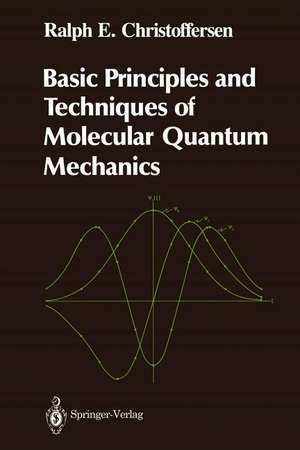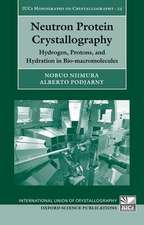Basic Principles and Techniques of Molecular Quantum Mechanics: Springer Advanced Texts in Chemistry
Autor Ralph E. Christoffersenen Limba Engleză Paperback – 21 mar 2012
Preț: 411.64 lei
Nou
Puncte Express: 617
Preț estimativ în valută:
78.77€ • 82.62$ • 65.57£
78.77€ • 82.62$ • 65.57£
Carte tipărită la comandă
Livrare economică 01-15 aprilie
Preluare comenzi: 021 569.72.76
Specificații
ISBN-13: 9781468463620
ISBN-10: 1468463624
Pagini: 704
Ilustrații: XIV, 686 p.
Dimensiuni: 155 x 235 x 37 mm
Greutate: 0.97 kg
Ediția:Softcover reprint of the original 1st ed. 1989
Editura: Springer
Colecția Springer
Seria Springer Advanced Texts in Chemistry
Locul publicării:New York, NY, United States
ISBN-10: 1468463624
Pagini: 704
Ilustrații: XIV, 686 p.
Dimensiuni: 155 x 235 x 37 mm
Greutate: 0.97 kg
Ediția:Softcover reprint of the original 1st ed. 1989
Editura: Springer
Colecția Springer
Seria Springer Advanced Texts in Chemistry
Locul publicării:New York, NY, United States
Public țintă
ResearchCuprins
1 Experimental Basis of Quantum Theory.- 1-1. Introductory Remarks.- 1-2. Classical Concepts of Linear Momentum, Angular Momentum, and Energy.- 1-3. Energy Levels and Photons.- 1-4. Electron Impact Experiments.- 1-5. Atomic Spectra.- 1-6. Quantization of Angular Momentum.- 1-7. Momentum of a Photon.- 1-8. Wave-Particle Duality.- Problems.- 2 Vector Spaces and Linear Transformations.- 2-1. Vector Spaces.- 2-2. Linear Independence, Bases, and Dimensionality.- 2-3. Inner Product Spaces.- 2-4. Orthonormality and Complete Sets.- 2-5. Hilbert Space.- 2-6. Function Space and Generalized Fourier Series.- 2-7. Isomorphism between Hilbert Space and Function Space.- 2-8. Examples of Complete Sets of Functions.- 2-9. Extension to Continuum Functions.- 2-10. Function Minimization with Constraints.- 2-11. Linear Operators.- 2-12. Algebra of Linear Operators.- 2-13. Special Kinds of Linear Operators.- 2-14. Eigenvalues and Eigenvectors.- Problems.- 3 Matrix Theory.- 3-1. Elements of Matrix Algebra.- 3-2. Determinants.- 3-3. Characterization of Square Matrices.- 3-4. Matrix Inversion.- 3-5. Matrices Having Special Properties.- 3-6. Matrix Representations of Linear Operators and Matrix Transformations.- 3-7. Changes of Basis and Similarity Transformations.- 3-8. Matrix Eigenvalue Problems.- 3-9. Infinite Matrices and Linear Transformations on Hilbert Space.- 3-10. Dirac Notation.- Problems.- 4 Postulates of Quantum Mechanics and Initial Considerations.- 4-1. Quantum Mechanical States and Observables.- 4-2. Time Evolution of a Quantum State.- 4-3. Quantum Theory of Measurement and Expectation Values.- 4-4. Compatible Observables and Commuting Operators.- 4-5. Constants of Motion and Transition Probabilities.- 4-6. Different Pictures of Quantum Phenomena.- 4-7. Hamiltonian Operator Construction: Initial Considerations.- Problems.- 5 One-Dimensional Model Problems.- 5-1. General Comments.- 5-2. Wavefunction Criteria and Boundary Conditions.- 5-3. The Nondegeneracy Theorem.- 5-4. Particle on a Ring.- 5-5. Particle Trapped in a Box.- 5-6. Parity of Eigenfunctions.- 5-7. Square Well Potential.- 5-8. Double Wells and Tunneling.- 5-9. The Harmonic Oscillator.- 5-10. Zero Point Energy and the Uncertainty Principle.- Problems.- 6 Angular Momentum.- 6-1. Introduction.- 6-2. General Angular Momentum Considerations.- 6-3. Orbital Angular Momentum.- 6-4. Spin Angular Momentum.- Problems.- 7 The Hydrogen Atom, Rigid Rotor, and the H2+ Molecule.- 7-1. Separation of Motion of Center of Mass.- 7-2. Solution of Equation for Relative Electron Motion of the Hydrogen Atom and Hydrogen-Like Atoms.- 7-3. Wavefunction Shapes.- 7-4. Rigid Rotor.- 7-5. The H2+ Molecule.- Problems.- 8 The Molecular Hamiltonian.- 8-1. General Principles and Discussion.- 8-2. Introduction of External Fields.- 8-3. Introduction of Relativistic Effects.- 8-4. The Born-Oppenheimer Approximation.- Problems.- 9 Approximation Methods for Stationary States.- 9-1. The Variation Principle.- 9-2. Accuracy Considerations.- 9-3. Example: The Hydrogen Atom.- 9-4. Example: Variational Treatment of the Helium Atom.- 9-5. The Linear Variation Method.- 9-6. Example: The Hydrogen Atom Revisited.- 9-7. Lower Bounds.- 9-8. Rayleigh-Schrödinger Perturbation Theory.- 9-9. Brillouin-Wigner Perturbation Theory.- Problems.- 10 General Considerations for Many Electron Systems.- 10-1. Early Computational Concepts and Procedures.- 10-2. Symmetry Considerations and Group Theory.- 10-3. Antisymmetry and the Pauli Exclusion Principle.- 10-4. Multielectron Systems and Slater Determinants.- 10-5. Expansion Theorem and SlaterDeterminant Expansions.- 10-6. Matrix Elements between Slater Determinants.- 10-7. Virial Theorem, Hypervirial Theorem, and Hellmann-Feynman Theorem.- 10-8. Scaling.- 10-9. Coupling of Angular Momenta.- 10-10. Orbital Transformations.- Problems.- 11 Computational Techniques for Many-Electron Systems Using Single Configuration Wavefunctions.- 11-1. Hartree-Fock Theory for Closed Shell Systems.- 11-2. Hall-Roothaan LCAO-MO-SCF Theory for Closed Shell Systems.- 11-3. Hartree-Fock Theory for Open Shell Systems.- Problems.- 12 Beyond Hartree—Fock Theory.- 12-1. Electron Correlation: General Comments.- 12-2. Configuration Interaction.- 12-3. Specialized CI Approaches.- 12-4. Many-Body Perturbation Theory and Coupled Cluster Theory.- Problems.- Appendix 1.- References.


















